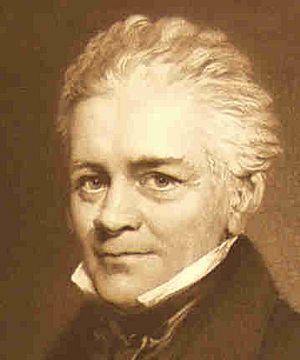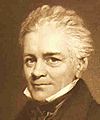William Cubitt facts for kids
Quick facts for kids
Sir William Cubitt
|
|
|---|---|
 |
|
| Born |
Dilham, Norfolk, England
|
| Baptised | 9 October 1785 |
| Died | 13 October 1861 (aged 76) Clapham Common, London, England
|
| Children | 4, including Joseph |
| Engineering career | |
| Discipline | Civil engineer, Millwright |
| Institutions | Institution of Civil Engineers (president) |
| Projects | The Crystal Palace Welwyn Viaduct |
| Significant design | Patent sails for windmills Prison treadwheels |
Sir William Cubitt (born October 9, 1785 – died October 13, 1861) was a very important English civil engineer and a millwright. A millwright is someone who designs and builds mills, especially windmills. Born in Norfolk, England, he worked on many big engineering projects of his time.
He invented a special type of windmill sail and the prison treadwheel. He was the chief engineer at a company called Ransomes in Ipswich before moving to London. In London, he worked on canals, docks, and railways, like the South Eastern Railway and the Great Northern Railway. He was also the main engineer for The Crystal Palace, a huge glass building built in Hyde Park in 1851.
William Cubitt was also the president of the Institution of Civil Engineers from 1850 to 1851. This is a very respected group for engineers.
Contents
Early Life and First Jobs
William Cubitt was born in Dilham, Norfolk. His father, Joseph Cubitt, was a miller, which means he operated a mill to grind grain. William went to the village school. When he was young, he helped his father at the mill.
In 1800, he started learning to be a cabinet-maker, making furniture. After four years, he left that job. He went back to work with his father in 1804 and even built a machine for splitting animal hides. Later, he joined another machine maker named Cook, where they built machines for farms, like horse threshing machines.
Engineer and Inventor: Smart Ideas
William Cubitt became known for making very precise and well-finished parts for machines made of iron. In 1807, he invented and patented self-regulating sails for windmills. This was a big deal because it made windmills much more efficient. At this time, he started his own business as a millwright in Horning, Norfolk.
In 1812, he got a job at Messrs. Ransome in Ipswich, a famous engineering company. He quickly became their chief engineer. He worked there for nine years and then became a partner in the company before moving to London in 1826.
The Treadmill Invention
Around 1818, Cubitt invented the treadmill. His first idea for the treadmill was to use it to grind corn or do other work, not mainly as a punishment. However, it was soon used in many large prisons across the United Kingdom. It helped to keep prisoners busy and provided a way for them to do physical labor.
From 1814, Cubitt also worked as a civil engineer. After moving to London, he became very busy with important projects. He worked a lot on canals, like the Oxford Canal. He also helped improve the River Severn and made reports about other rivers. In 1841, he designed a new wharf (a place for ships to load and unload) on the Regent's Canal in London. This allowed goods to be easily moved between canals, roads, and railways. He also worked on docks in Cardiff and Middlesbrough.
Building Railways: Connecting Places
When railways became popular, William Cubitt was often asked for his expert opinion in important discussions about new rail lines. He was the chief engineer for the South Eastern Railway. For this project, he used a huge amount of gunpowder (18,000 pounds!) to blast away part of Round Down Cliff between Folkestone and Dover. This made space to build the railway line along the beach, with a tunnel under Shakespeare Cliff.
He also worked on the Great Northern Railway as a consulting engineer. He brought in the newest ideas and technologies for this railway. Other countries also asked for his help. The government of Hanover (a part of Germany) asked for his advice on their harbor and docks. He also directed the work to supply Berlin with water and surveyed the railway line between Paris and Lyon in France.
After the railway to Folkestone was finished, and a ferry service to Boulogne in France started, he helped improve the port there. He then became a consulting engineer for the railway line between Boulogne and Amiens. Some of his last projects included two large landing stages in Liverpool and a bridge over the River Medway in Rochester, Kent.
Honors and Later Life
William Cubitt joined the Institution of Civil Engineers in 1823. He became a council member in 1831, vice-president in 1836, and then president in 1850 and 1851. While he was president in 1851, he played a very important role in building the Great Exhibition building, which was the famous The Crystal Palace in Hyde Park. Because of his great work, Queen Victoria made him a knight on December 23, 1851, so he became "Sir" William Cubitt. He was also a member of the Royal Society, a very old and respected group of scientists.
One of Cubitt's nephews, James Moore, also became an engineer and worked with him on railways. James Moore later became the Chief Engineer for the first commercial steam railway in Melbourne, Australia.
Sir William Cubitt retired from his work in 1858. He passed away at his home in Clapham Common, Surrey, on October 13, 1861. He was buried in Norwood cemetery.
Family Life
William Cubitt was born on October 9, 1785. His parents were Joseph Cubitt and Hannah Lubock. He had two brothers, Benjamin and Joseph.
Marriages and Children
William Cubitt married Abigail Sparkhall on June 26, 1809. They had one son, Joseph, and two daughters. Their son, Joseph Cubitt (1811–1872), followed in his father's footsteps and also became a civil engineer.
After Abigail passed away, William Cubitt married Elizabeth Jane Tiley on January 24, 1821. They had a son named William, who was born in 1830.
Amazing Structures by Cubitt
Many of the structures William Cubitt designed or helped build are still standing today! Here are some of them:
- Many windmills in East Anglia and Lincolnshire
- Iron bridges in places like Brent Eleigh, Clare, and the Stoke Bridge at Ipswich
- The Port Offices in Lowestoft
- The Haddiscoe Cut, a canal
- Parts of the Oxford Canal near Rugby
- The Diglis Lock on the River Severn at Worcester
- The Foord Viaduct (a bridge-like structure) in Folkestone
- Several tunnels, including Folkestone Warren, Martello, Abbot's Cliff, Shakespeare, and Martello tunnels
- The Welwyn Viaduct, a very long railway bridge
- The Nene Bridge in Peterborough
- The building that is now the Museum of Childhood in Bethnal Green
Cubitt also built Penton Lodge, a building located in Penton Mewsey.
Images for kids


